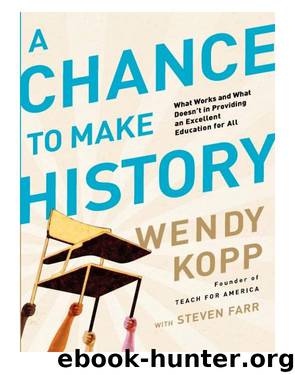A Chance to Make History by Wendy Kopp

Author:Wendy Kopp [Kopp, Wendy]
Language: eng
Format: epub
Publisher: PublicAffairs
Published: 2011-12-28T17:00:00+00:00
THE COSTLY FIXATION ON SILVER BULLETS
The urgency of the achievement gap makes us yearn for a quick fix that will close it. Yet everything we are learning from the most successful classrooms, schools, charter management organizations, and districts proves that there are no shortcuts.
It’s Not All About More Funding
Several years ago, I had the opportunity to take a presidential candidate on a tour of KIPP Gaston Prep, a school in rural North Carolina that was showing record-breaking results with a population of students living at or near the poverty line. The school is a picture of simplicity. Like so many of the highest-performing charter schools in the country, only minimal and necessary attention was put into the school building itself, and the school is working with fewer dollars per pupil than traditional schools.
Launched in 2001 as the third school in the KIPP network, KIPP Gaston Prep has a student body that is 86 percent African American, with more than 65 percent of its students qualifying for free or reduced lunch. Although it was opened as a middle school, it quickly evolved into an institution serving fifth through twelfth grades. The results are impressive: In the first two high school graduating classes, the classes of 2009 and 2010, 100 percent of seniors were accepted to college.2
I watched as the presidential candidate questioned Caleb Dolan and Tammi Sutton, the Teach For America alumni who had pioneered the school’s development. He just didn’t believe they could achieve the results they did with the same level of funding as the school down the road. Caleb persisted patiently, explaining that actually they were spending only 85 percent as much as the other school since their allocation of public dollars was less.
Throughout the morning, the candidate’s skepticism remained strong. During lunch, however, I wondered if it might be dissipating. Caleb and Tammi had invited some of the students’ parents to come to the school at lunchtime for an informal discussion. Listening to the parents, it became clear that the school was actually breaking the cycle of poverty. The parents were describing the change in their children—the fact that their children were now waking them up to make sure they got to school on time. One parent explained that thanks to this school, he knew he would retire in comfort.
As we sat down in the plane to go back home, the candidate said, “This visit really made an impact on me.” I was surprised, and he continued: “It had never actually occurred to me that this might not be a resources issue—that actually, it’s about believing in the kids.”
Politicians, parents, and school leaders often point to funding as the critical issue. In fact, when we visited the middle school a couple of miles away from KIPP Gaston Prep, the entire focus of the faculty’s discussion with the candidate was their concern about insufficient financial resources.
Constraining resources certainly play a role in limiting what a school can do, and in some states it is a much greater barrier than in others.
Download
This site does not store any files on its server. We only index and link to content provided by other sites. Please contact the content providers to delete copyright contents if any and email us, we'll remove relevant links or contents immediately.
| Administration | Assessment |
| Educational Psychology | Experimental Methods |
| History | Language Experience Approach |
| Philosophy & Social Aspects | Reform & Policy |
| Research |
The Art of Coaching Workbook by Elena Aguilar(50961)
Trainspotting by Irvine Welsh(21515)
Twilight of the Idols With the Antichrist and Ecce Homo by Friedrich Nietzsche(18501)
Fangirl by Rainbow Rowell(9093)
Periodization Training for Sports by Tudor Bompa(8167)
Change Your Questions, Change Your Life by Marilee Adams(7631)
This Is How You Lose Her by Junot Diaz(6777)
Asking the Right Questions: A Guide to Critical Thinking by M. Neil Browne & Stuart M. Keeley(5627)
Grit by Angela Duckworth(5512)
Red Sparrow by Jason Matthews(5389)
Paper Towns by Green John(5086)
Room 212 by Kate Stewart(5034)
Ken Follett - World without end by Ken Follett(4643)
Housekeeping by Marilynne Robinson(4328)
The Sports Rules Book by Human Kinetics(4288)
Double Down (Diary of a Wimpy Kid Book 11) by Jeff Kinney(4204)
Papillon (English) by Henri Charrière(4195)
The Motorcycle Diaries by Ernesto Che Guevara(4008)
Exercise Technique Manual for Resistance Training by National Strength & Conditioning Association(3953)
